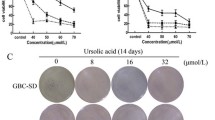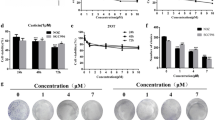Abstract
The effect of noncytotoxic doses of argemone oil (AO) and butter yellow (BY), the common adulterants in edible oil, on free radical generation and signaling pathway for cell proliferation in primary cells of gall bladder (GB) was undertaken. AO and BY showed no cytotoxicity at 0.1 μl/ml and 0.1 μg/ml concentration, respectively. AO caused significant increase in ROS after 30 min and RNS after 24 h in GB cells while no change was observed following BY treatment. Enhanced level of COX-2 was observed following AO (0.1 μl/ml) and BY (0.1 μg/ml) treatment to cells for 24 h. AO treatment caused phosphorylation of ErbB2, AKT, ERK, and JNK along with increased thymidine uptake indicating cell proliferation ability in GB cells. BY treatment also showed significant expression of these proteins with the exception of phosphorylated JNK. These results suggest that AO and BY have cell proliferative potential in GB cells following up-regulation of COX-2 and ErbB2; however, their downstream signaling molecules and free radical generation have differential response, indicating that the mechanism of proliferation is different for both compounds and may have relevance in gall bladder cancer.





Similar content being viewed by others
Abbreviations
- AO:
-
Argemone oil
- BY:
-
Butter yellow
- EMEM:
-
Eagle's minimum essential medium
- MEM:
-
Minimum essential medium
- HBSS:
-
Hank's balanced salt solution
- FBS:
-
Fetal bovine serum
- LDH:
-
Lactate dehydrogenase
- MTT:
-
3-(4,5-dimethyl-2-yl)-2,5-dipehyl tetrazolium bromide
- DMSO:
-
Dimethyl sulphoxide
- PBS:
-
Phosphate buffer saline
- ErbB2:
-
Neu proto oncogene
- COX-2:
-
Cyclo oxigenase-2
- AKT:
-
Serine threonine kinase
- ERK:
-
Extracellular signal regulated kinase
- JNK:
-
Jun-amino terminal kinase
References
Ashby J, Elliott BM, Lefevre PA, Styles J, Longstaff E. Initiation/promotion versus complete carcinogenicity in the rodent liver. Environ Health Perspect. 1983;50:339–46.
Babu CK, Ansari KM, Mehrotra S, Patel S, Dikshit M, Das M. Activation of inflammatory response and apoptosis of polymorphonuclear leukocytes in patients with argemone oil poisoning. Chem Biol Interact. 2010;183:154–64.
Batra Y, Pal S, Dutta U, Desai P, Garg PK, Makharia G. Gall bladder cancer in India: a dismal picture. J Gastroenterol Hepatol. 2005;20:309–14.
Darzynkiewicz Z, Bruno S, Del BG, Gorczyca W, Hotz MA, Lassota P. Features of apoptotic cells measured by flow cytometry. Cytometry. 1992;13:795–808.
Das M. Food contamination and adulteration. In e book Environmental Biochemistry, National Science Digital Library, National Institute of Science Communication & Information Resources, New Delhi. 2008; pp 1–32.
Das M, Khanna SK. Clinicoepidemiological, toxicological, and safety evaluation studies on argemone oil. Crit Rev Toxicol. 1997;27:273–97.
Das M, Khanna SK. Epidemic dropsy. Natl Med J India. 1998;11:207–8.
Dhir V, Mohandas KM. Epidemiology of digestive tract cancers in India IV. Gall bladder and pancreas. Indian J Gastroenterol. 1999;18:24–8.
Ding AH, Nathan CF, Stuecher DJ. Release of reactive nitrogen intermediate from mouse peritoneal macrophages: comparison of activating cytokines and evidences for independent production. J Immunol. 1988;141:2407–12.
Eberhart CE, Coffey RJ, Radhika A, Giardiello FM, Ferrenbach S, DuBois RN. Up-regulation of cyclooxygenase 2 gene expression in human colorectal adenomas and adenocarcinomas. Gastroenterology. 1994;107:1183–8.
Endo K, Yoon BI, Pairojkul C, Demetris AJ, Sirica AE. ErbB-2 overexpression and cyclooxygenase-2 up-regulation in human cholangiocarcinoma and risk conditions. Hepatology. 2002;36:439–50.
Fortner JG. The experimental induction of a primary carcinoma of the gall bladder. Cancer. 1955;8:689–700.
Fubini B, Hubbard A. Reactive oxygen species (ROS) and reactive nitrogen species (RNS) generation by silica in inflammation and fibrosis. Free Rad Biol Med. 2003;34:1507–16.
Han M-J, Kim B-Y, Yoon S-O, Chung A-S. Cell proliferation induced by reactive oxygen species is mediated via mitogen activated protein kinase in Chinese Hamster Lung Fibroblast (V79) cells. Mol Cells. 2003;15:94–101.
Hussain AR, Al-Jomah NA, Siraj AK, Manogaran P, Al-Hussein K, Abubaker J, et al. Sanguinarine-dependent induction of apoptosis in primary effusion lymphoma cells. Cancer Res. 2007;67:3888–97.
Indian Council of Medical ResearchAnnual Report of Population Based Cancer Registries of the National Cancer Registry Programme (1993). 1996; 18: New Delhi: ICMR Publication.
Ishii H, Furuse J, Yonemoto N, Nagase M, Yoshino M, Sato T. Chemotherapy in the treatment of advanced gall bladder cancer. Oncology. 2004;66:138–42.
Ito H, Matros E, Brooks DC, Osteen RT, Zinner MJ, Swanson RS, et al. Treatment outcomes associated with surgery for gall bladder cancer: a 20-year experience. J Gastrointest Surg. 2004;8:183–90.
Jarnagin WR, Ruo L, Little SA, Klimstra D, D'Angelica M, DeMatteo RP, et al. Patterns of initial disease recurrence after resection of gall bladder carcinoma and hilar cholangiocarcinoma: implications for adjuvant therapeutic strategies. Cancer. 2003;98:1689–700.
Jemal A, Siegel R, Ward E, Murray T, Xu J, Thun MJ. Cancer statistics. CA Cancer J Clin. 2007;57:43–66.
Khan JS. Blended mustard oil for health benefits. In: Bhatnagar AK, Singh AK, Prakash S, editors. Health and dietary aspects of mustard oil. New Delhi: Mustard Research and Promotion Consortium; 2001. p. 132–8.
Khanna SK, Das M. Toxicity, carcinogenicity and clinicoepidemiological studies on dyes and dye-intermediates. J Sci Ind Res. 1991;50:965–74.
Kornberg A. Lactate dehydrogenase of muscle. In: Colowick SP, Kaplan NO, editors. Methods in enzymology, vol. 1. New York: Academic; 1955. p. 441–54.
Kresl JJ, Schild SE, Henning GT, Gunderson LL, Donohue J, Pitot H, et al. Adjuvant external beam radiation therapy with concurrent chemotherapy in the treatment of gall bladder carcinoma. Int J Radiat Oncol Biol Phys. 2002;52:167–75.
Kuver R, Savard C, Nguyen TD, Osborne WRA, Sum PL. Isolation and long-term culture of gall bladder epithelial cells from wild-type and cf mice. In Vitro Cell Dev Biol-Animal. 1997;133:104–9.
Levy AD, Murakata LA, Rohrmann CA. Gall bladder carcinoma: radiologic–pathologic correlation. Radiographics. 2001;21:295–314.
Mishra V, Saxena DK, Das M. Effect of argemone oil, argemone alkaloid and sanguinarine on sertoli-germ cell coculture. Tox Lett. 2009;186:104–10.
Mishra V, Mishra M, Ansari KM, Chaudhuri BP, Khanna R, Das M. Edible oil adulterants, argemone oil and butter yellow, as etiological agents for gall bladder cancer. European J. Cancer 2011 (in press)
Misra S, Chaturvedi A, Misra NC, Sharma ID. Carcinoma of the gall bladder. Lancet Oncol. 2003;4:167–76.
Miyazaki M, Wahid S, Matsuura K, Tsunashima M, Nakabayashi H, Miyano K, et al. Effect of 3′-methyl-4-dimethylaminoazobenzene on liver cells from adult rat in primary culture. Res Exp Med (Berl). 1982;181:27–38.
Na AR, Chung TM, Lee SB, Park SH, Lee MS, Yoo YD. A critical role of Romo 1 derived ROS in cell proliferation. Biochem Biophys Res Commun. 2008;369:672–8.
Obara T, Tanno S, Fujii T, Izawa T, Mizukami Y, Yanagawa N, et al. Epithelial cell proliferation and gene mutation in the mucosa of the gall bladder with pancreaticobiliary malunion and cancer. J Hepatobiliary Pancreat Surg. 1999;6:229–36.
Ristimaki A, Sivula A, Lundin J, Salminen T, Haglund C, Joensuu H, et al. Prognostic significance of elevated cyclooxygenase-2 expression in breast cancer. Cancer Res. 2002;62:632–5.
Sebolt-Leopold JS, Dudley DT, Herrera R. Blockade of the MAP kinase pathway suppresses growth of colon tumors in vivo. Nat Med. 1999;5:810–6.
Snedecar GW, Cochran WG. One way classification: analysis of variance. In: Statistical Methods, sixth ed. Iowa State, University Press, Ames, Iowa, 1967; 258–296.
Steele VE, Boone CW. Cellular and molecular targets for chemoprevention. Kensler TW, Trush MA, Guyton KZ. In: Free radicals as targets for cancer chemoprotection: prospects and problems, 1992; 174.
Taketo MM. Cyclooxygenase-2 inhibitors in tumorigenesis. J Natl Cancer Inst. 1998;90:1529–36.
Taner CB, Nagorney DM, Donobue HD. Surgical treatment of gall bladder cancer. J Gastrointest Surg. 2004;8:83–9.
Treekitkarnmongkol W, Suthipongchai T. High expression of ErbB2 contributes to cholangiocarcinoma cell invasion and proliferation through AKT/p70S6K. World J Gastroenterol. 2010;16:4047–54.
Upreti KK, Das M, Khanna SK. Biochemical toxicology of argemone oil. i: effect on hepatic cytochrome P-450 and xenobiotic metabolizing enzymes. J Appl Toxicol. 1991;46:203–9.
Wang JF, Jerrells TR, Spitzer JJ. Decreased production of reactive oxygen intermediates is an early event during in vitro apoptosis of rat thymocytes. Free Rad Biol Med. 1996;20:533–42.
Wharton BA. Human nutrition. Science. 1980;209:1011–2.
Zabezhinskii MA, Pliss GB, Okulov VB, Petrov AS. Comparison of the effect of different carcinogens on the skin of rats. Eksp Onkol. 1984;6:24–7.
Acknowledgements
We are grateful to the Director of our Centre for his keen interest in the study. One of us (V M) is thankful to Council of Scientific and Industrial Research (CSIR)/University Grant Commission (UGC), New Delhi for the award of Senior Research Fellowship. Financial assistance of CSIR Supra Institutional Project (SIP-08) is gratefully acknowledged. The manuscript is IITR communication #2901.
Conflict of interest
The authors declare that there are no conflicts of interest.
Author information
Authors and Affiliations
Corresponding author
Rights and permissions
About this article
Cite this article
Mishra, V., Ansari, K.M., Khanna, R. et al. Role of ErbB2 mediated AKT and MAPK pathway in gall bladder cell proliferation induced by argemone oil and butter yellow. Cell Biol Toxicol 28, 149–159 (2012). https://doi.org/10.1007/s10565-011-9207-5
Received:
Accepted:
Published:
Issue Date:
DOI: https://doi.org/10.1007/s10565-011-9207-5




